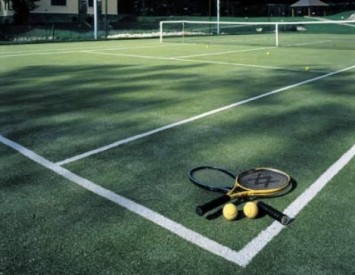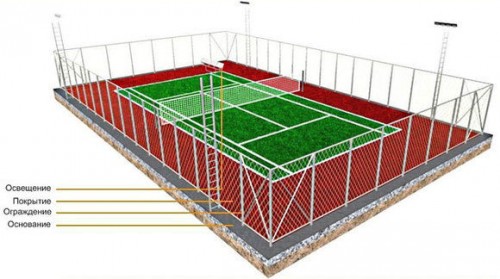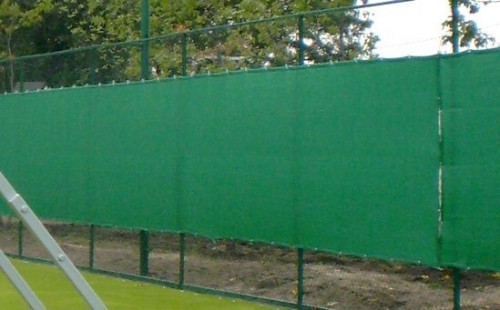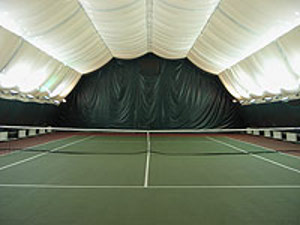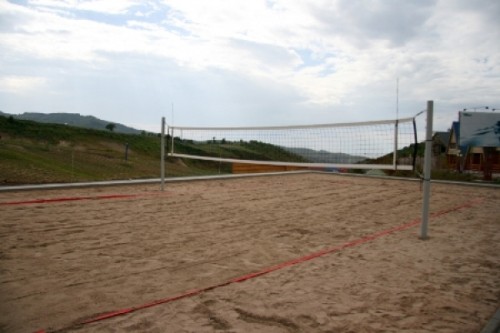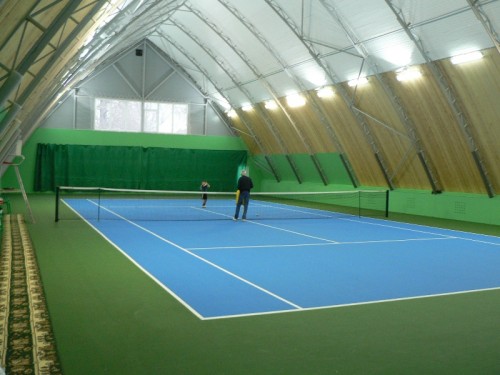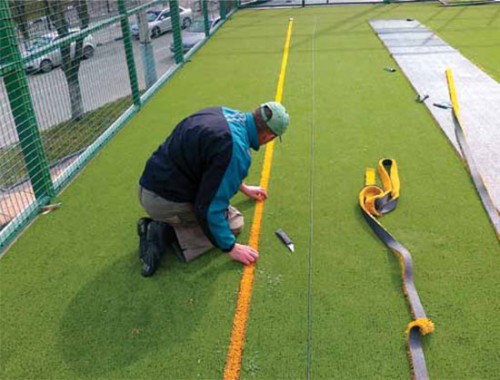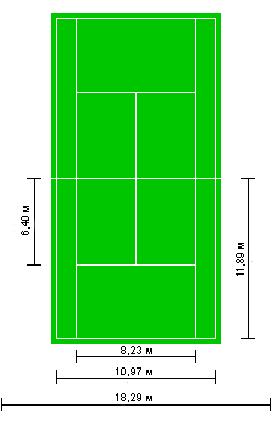District houses and plots next to them are less and less reminiscent of a cottage with a garden and ascetic living conditions. Saunas, wine cellars, beaches, the latest home technique - all this ceased to be a curiosity, but became the usual attribute of a country household. Today we will talk about another attribute of well -being as a tennis court, and the possibility of its arrangement on its own.
Content
The main points that need to be carefully thought out by plotting the construction of tennis courts will be presented later.
Fence
Usually, it is a grid 3-4 m high, stretched between supports (pillars). If you have such an opportunity, then instead of a grid you can use special anti -white screens.
Lighting
Lovers of evening leisure should be worried about lighting devices in advance. They should be raised to a height of 6-8 m. These lamps with a capacity of at least 200 W is better to prepare 5-10 pcs.
Protection from rain and cold
The indoor tennis court is pocket not everyone, but it would be wonderful to equip the court with a roof. Frame structures and structures from sandwich panels can also be equipped with a heating system. Then the site can be operated even in winter.
Coating
This is the most expensive part of the court, well, and the most important.
Tennis court coating options
- Soil coating.
- Herbal coating.
- Carpet.
- Solid coating.
- Plastic coating.
Stages of arranging a coating for a tennis site
- Earth alignment.
- The creation of a “pillow” (the composition of the “pillows” and various coatings for the courts differ).
Soil coating
Advantages:
- Reduced injury hazard.
- The possibility of quick construction (from 3 weeks).
- Relative cheapness.
Flaws:
- Drinks for a long time.
- After the game, a special brush is required.
- Its need to be carefully cleaned of fallen foliage regularly.
- The need for restoration in the spring.
The restoration of such a coating is carried out using a tennesite (special mix of sand, clay, marble crumbs and other additives for the formation of a tennis site). For the initial creation of a tennis court, about 40 tons of this mixture will be needed. From this mass you get a rammed pillow 4 cm high. 4 tons may be enough for restoration.
Herbal coating
This coating is characteristic of professional courts, on its own area there is no opportunity to organize proper care for the lawn.
Advantages:
- Aesthetics.
- Environmental friendliness.
Flaw:
- The need to attract professionals for care.
Solid coating
Such a coating involves the styling of acrylic on a concrete site.
Classification of solid coating:
- Hard (3-4 layers of acrylic).
- Traumatic security (7 or more layers).
Advantages:
- A variety of color solutions.
- Durability (service life of more than 10 years).
- Ease of maintenance (the main task is to collect water after rain with a rubber mop).
Flaw:
- Long period of arrangement (2-3 months).
Plastic coating
This is an analogue of solid coating for amateur courts, collected from plastic modules. The concrete screed is also based on.
Advantages:
- Lack of need for special care.
- The water after the rain quickly “leaves”.
Flaw:
- Expelity to the pernicious effect of temperature changes (be interested in warranty period).
- Carpet
This is an artificial substitute for herbal coating, less capricious and simpler in care. Artificial fibers on a latex basis after laying are covered with quartz sand. As a substrate, concrete or granite screening is used.
Classification of artificial grass:
- Folding (fiber length up to 20 mm).
- Half -off (fiber length - 10mm).
Advantages:
- Simplicity of service.
- The speed of creation.
Flaws:
- Sand must be sprinkled over time.
- In dry weather, it requires moisture.
- With excessive watering, the surface becomes slippery.
The basis for the coating
Not exactly a verified foundation can ruin the effect of the selected expensive coating materials. The depth of the base is -40-60 cm, the thickness of the concrete layer -15 cm. The difference is the lower inhibit layer of crushed stone and sand. Although, depending on the type of natural soil, sometimes this layer can be neglected. Each layer, as a rule, is rammed with a construction roller. For a better drainage, the court should be located at an angle along the short side. If a professional team is engaged in the arrangement of the court, then the design is equipped in advance by a whole system of gutters for drainage.
Tips for those who decided to make a court on their own
If you have experience in construction work, then you can make a tennis court with your own hands. We give an indicative description of this process and its key points.
How long will it take?
The arrangement of a tennis site can take from 10 to 30 days. This is influenced by the type of coating and equipment.
What do you need?
- land plot of suitable size;
- materials for the foundation and coating of the court;
- frowning mesh;
- pillars for fencing;
- racks for lamps;
- lighting lights;
- building tools;
- construction rink.
Court position
The long side of the site should be located from north to south. Such a placement will be the key to the fact that the Sun will not blind players in the eyes during the duel.
The size of the tennis court
Let us take as a basis the assumption that if you decide to make a court on your site, then the area of \u200b\u200bthe site allows this. But still, when planning such a site, the fate of the features and prospects of its use is necessary.
- Standard size: 18x36 m.
- Court for a single game: 23.77x8.23 m.
- Tennis court for children and beginners: 17x34 m (16x32 m).
- For an unprofessional court, you can take an approximate size with a margin: 40x20 m.
Below is a indicative plan, based on which a tennis court is created (photo).
- The site should have a flat and compacted surface, on this it will directly depend on how the ball will bounce on it.
- Divide the site with a nylon grid (12.8x1.06 m) with a white edging along the upper edge, into which the cable for stiffness is inserted.
- The distance from the side line of the court to the pillars is 0.91 m.
- Make the fence from a metal grid stretched between the pillars.
- Pillars can be metal or wooden. They need to be concreted to a depth of 0.75-1.2 m.
- The height of the poles is equal to the height of the grid. The pillars themselves should be equipped with special mounts for fixing the grid on them.
- If desired, the pillars on which the nylon mesh is attached can be made removable. To do this, they are inserted into glasses from pipes 0.9 m long and with a diameter of 0.2 m, firmly concrete.
- Along the fence, plant climbing plants, such as vines or ivy, which are later thick shoots on the grid.
- The seizure for the foundation should be at least 0.25 m.
- At the bottom of this seizure, make drainage grooves by filling them with gravel or slag.
- On the finished base, pour a layer of crushed stone (with a size of 5-10 cm) with a thickness of 0.1 m.
- Remove the underlying layer with a construction rink and pour for the best shrinkage.
- Now make the next layer of slag with particles size 2-5 cm. The layer thickness is 0.12 m.
- Now roll this intermediate layer.
- Pour the cover layer (5 cm) from a special mixture (construction sarying - 70%, clay in powder form - 15%, plant land - 15%). To increase moisture content, add salt at the rate of 500 g/1 m2.
- The mixture forming the surface layer, tint the red tuff so that the ball is clearly visible on the court.
- Seal the top layer with a roller.
- Pour the surface with a thin even layer of sand.
- Remove again and sweep excess sand with a soft brush.
- Mark the lines using the square, relying on the plan.
- Pull the lines with white. The width of the end lines is 10 cm, all the others - 5 cm.
- Pillars of the fencing and pillars for tensioning the grid paint with two layers of green-oil paint.
Necessary little things
Court is a place of interesting and mobile holidays. To increase its comfort and facilitate the care of the surface, various additions may be needed.
- Ball baskets.
- Get and pillars for its fastening.
- Special brushes for "combing" coating.
- Roller (to remove moisture from a solid coating).
- Cleaner of plastic marking lines.
- Tennis gun.
- Machine for collecting balls.
It should be honestly admitted that the construction of a tennis court with your own hands is a very troublesome, difficult and costly matter. However, if there is desire and abilities, then the result will cost the effort. A pleasant and useful vacation is guaranteed to you!
